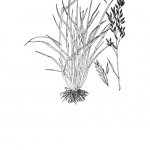Tall Fescue
Festuca arundinacea (Schreb.) Dumort., nom. cons.
Poaceae
Description
Tall fescue is a perennial, cool season, introduced species ranging from 18 to 48 inches or 0.45 to 1.2 m tall. Slender stems are produced from large crowns. The leaves have ridges that make their upper surfaces rough. The panicle is erect but nodding at maturity. The panicle’s lowest two nodes have 2 to 3 subequal branches, each having 5 to 15 spikelets. Pedicels are up to 8 mm in length. Spikelets are elliptic to oblong, with 3 to 10 florets, and disarticulating beneath each lemma at maturity. Dark green leaves appear in late winter, and it typically flowers in the spring. It is semi-dormant during the heat of summer but has whitish seed stalks persisting. Tall Fescue resumes growing in the fall and continues into early winter. This species can propagate by seed or vegetatively. Good grazing for livestock but can cause “fescue foot toxicity” in cattle. It is also known as “fescue toxicosis” or “summer slump.” Fair grazing for wildlife. Alkaloids produced by endophyte-infected plants can be toxic to small mammals and have low palatability for ungulate species (i.e., cattle and deer). Death loss is rare in cattle, but toxicity can cause impaired performance. Many ground-nesting bird species are unable to use Tall Fescue for foraging or nesting habitats due to a lack of structure and vegetation composition.Habitat
A native of Europe, Tall Fescue invades native grasslands, savannahs, woodlands, and other habitats receiving high amounts of light. Communities dominated by this species are typically low in plant species richness. It can occur in tufted clumps or colonies along forest margins, plantations, roadways, and clearings. Tall Fescue can grow on wet or dry sites. This species is widely distributed across the world and was established for turf, forage, soil stabilization, or wildlife food plots.Images
Plant Characteristics
Seed Type: Non-Encapsulated
Duration: Perennial
Stem Texture: Hairless/Smooth
Growth Habit: Bunch grass, Grasses
Leaf Shape
 : Simple with Pinnate or Parallel Venation
: Simple with Pinnate or Parallel Venation
Season: Cool
Distribution
 : 01 - Pineywoods, 02 - Gulf Prairies and Marshes, 03 - Post Oak Savannah, 04 - Blackland Prairies, 05 - Cross Timbers and Prairies, 07 - Edwards Plateau, 10 - Trans-Pecos
: 01 - Pineywoods, 02 - Gulf Prairies and Marshes, 03 - Post Oak Savannah, 04 - Blackland Prairies, 05 - Cross Timbers and Prairies, 07 - Edwards Plateau, 10 - Trans-Pecos
Distributions
Distribution refers to the ecological region in Texas that a plant has been found. You can also view a clickable map.
Book: Know Your Grasses (B-182)
Collection: Grasses


